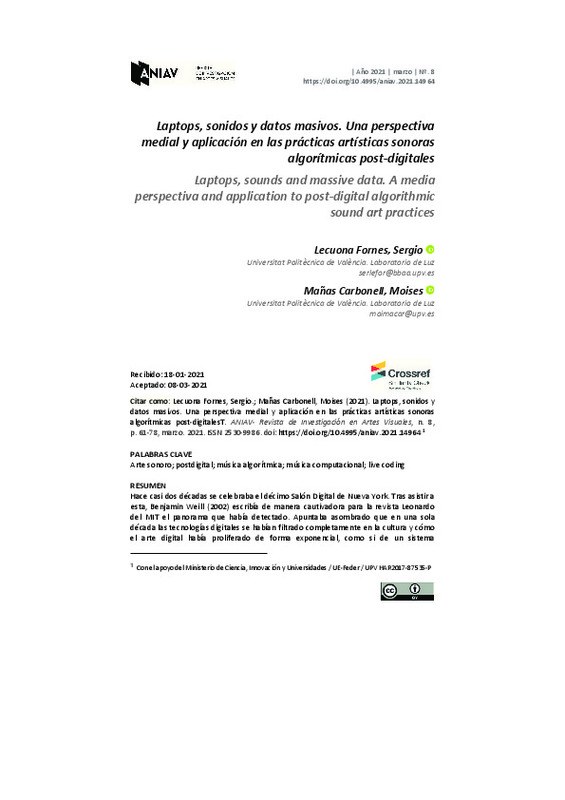Ariza, C. (2011). Two Pioneering Projects from the Early History of Computer‐Aided Algorithmic Composition. MIT Press. Recuperado de https://dspace.mit.edu/handle/1721.1/68626 https://doi.org/10.1162/COMJ_a_00068
Ashton, A. (2001). Harmonograph. A visual guide to the mathematics of Music. Glastonbury, UK: Wooden Books
Brøvig‐Hanssen, R., & Danielsen, A. (2016). Digital signatures: The impact of digitization on popular music sound. Cambridge, Massachusetts: The MIT Press. https://doi.org/10.7551/mitpress/10192.001.0001
[+]
Ariza, C. (2011). Two Pioneering Projects from the Early History of Computer‐Aided Algorithmic Composition. MIT Press. Recuperado de https://dspace.mit.edu/handle/1721.1/68626 https://doi.org/10.1162/COMJ_a_00068
Ashton, A. (2001). Harmonograph. A visual guide to the mathematics of Music. Glastonbury, UK: Wooden Books
Brøvig‐Hanssen, R., & Danielsen, A. (2016). Digital signatures: The impact of digitization on popular music sound. Cambridge, Massachusetts: The MIT Press. https://doi.org/10.7551/mitpress/10192.001.0001
Cádiz, R. F. (2012). Creación musical en la era postdigital. Aisthesis, (52), 449‐475. https://doi.org/10.4067/S0718-71812012000200023
Chojecki, P. (2020, junio 16). Moore's law is dead. Recuperado 28 de diciembre de 2020, de Medium website: https://towardsdatascience.com/moores‐law‐is‐dead‐ 678119754571
Collins, N., & McLean, A. (2017). Algorave: Live Performance of Algorithmic Electronic Dance Music. Journal of Electronic Dance Music Culture, 4.
Dean, R. T., & McLean, A. (Eds.). (2018). The Oxford handbook of algorithmic music. New York, NY: Oxford University Press. https://doi.org/10.1093/oxfordhb/9780190226992.001.0001
Eno, B. (1996). A year with swollen appendices. London: Faber and Faber.
Greshamlancaster, S. (1998). The Aesthetics and History of the Hub: The Effects of Changing Technology on Network Computer Music. Leonardo Music Journal, 8. https://doi.org/10.2307/1513398
Hermann, T. (2008). Taxonomy and Definitions for Sonification and Auditory Display. Proceedings of the 14th International Conference on Auditory Display, 8. Paris, France.
Hiller, L. (1970). "Music Composed with Computers: An Historical Survey". En H. B. Lincoln: The Computer and Music. Ithaca, New York: Cornell University Press, pp. 42-96. https://doi.org/10.7591/9781501744167
Kitchin, R. (2014). The Data Revolution: Big Data, Open Data, Data Infrastructures and Their Consequences. London: SAGE Publications. https://doi.org/10.4135/9781473909472
Koutsomichalis, M. (2016). From Music to Big Music: Listening in the Age of Big Data. Leonardo Music Journal, 26(26), 24‐27. https://doi.org/10.1162/LMJ_a_00962
Landy, L. (2003). Electroacoustic Music: Analytical Perspectives (review). Notes, 60(1), 162‐163. https://doi.org/10.1353/not.2003.0112
Lecuona‐Fornes, S. (2019). Arte, sonido, algoritmo y sociedad (ASAS): Sinergías entre las tecnologías, los datos masivos y el arte sonoro contemporáneo. (Master Thesis). UPV, Valencia.
López, J. C. (2018, enero 19). Fibra óptica a 1 Gbps: Qué nos aporta, cómo lo hace y qué vendrá después. Recuperado 3 de enero de 2021, de Xataka website: https://www.xataka.com/otros/fibra‐optica‐a‐1‐gbps‐que‐nos‐aporta‐como‐lo‐hace‐y‐ que‐vendra‐despues
Loy, D. G. (2006). Musimathics: The mathematical foundations of music. Cambridge, Mass
London: MIT Press. McLuhan, M. (1964). Understanding media: The extensions of man (2013.a ed.). Berkley, California: Gingko Press. Recuperado de http://public.eblib.com/choice/publicfullrecord.aspx?p=1222206
Mercier, L. (2001). Music, Arts, and Technology. A Critical Approach. Computer Music Journal, 25(4), 91‐92. https://doi.org/10.1162/01489260152815314
Pope, S. T. (1999). Web.La.Radia: Social, Economic, and Political Aspects of Music and Digital Media. Computer Music Journal, 23(1), 49‐56. https://doi.org/10.1162/014892699559643
Martín‐Prada, J. (s/f) "La nueva interactividad digital". Recuperado el 15 de enero de 2021, de http://reddigital.cnice.mec.es/3/firmas_nuevas/prada/prada_1.html
Risset, J. C. (2002). Foreword. En T. Licata (Ed.), Electroacoustic music: Analytical perspectives (pp. 4‐9). Westport, Conn: Greenwood Press.
Risset, J.‐C. (2007). Fifty Years of Digital Sound for Music. 6. Roads, C. (2015). Composing Electronic Music: A New Aesthetic. New York: Oxford University Press. https://doi.org/10.1093/acprof:oso/9780195373233.001.0001
Rowe, R. (2001). Machine musicianship. Cambridge, Mass: MIT Press.
Sturm, B. L., Ben‐Tal, O., Monaghan, Ú., Collins, N., Herremans, D., Chew, E., … Pachet, F. (2019). Machine learning research that matters for music creation: A case study. Journal of New Music Research, 48(1), 36‐55. https://doi.org/10.1080/09298215.2018.1515233
Turchet, L., Fazekas, G., Lagrange, M., Ghadikolaei, H., & Fischione, C. (2020). The Internet of Audio Things: State of the Art, Vision, and Challenges. IEEE Internet of Things Journal, PP, 1‐1. https://doi.org/10.1109/JIOT.2020.2997047
Weil, B. (2002). Art in Digital Times: From Technology to Instrument. Leonardo, 35(5), 523‐537. https://doi.org/10.1162/002409402320774349
[-]









